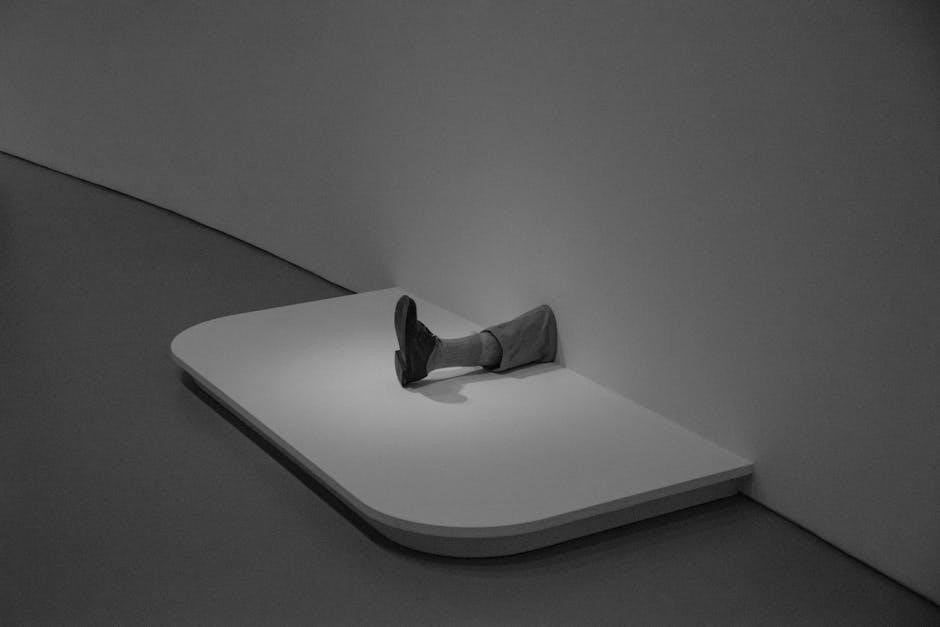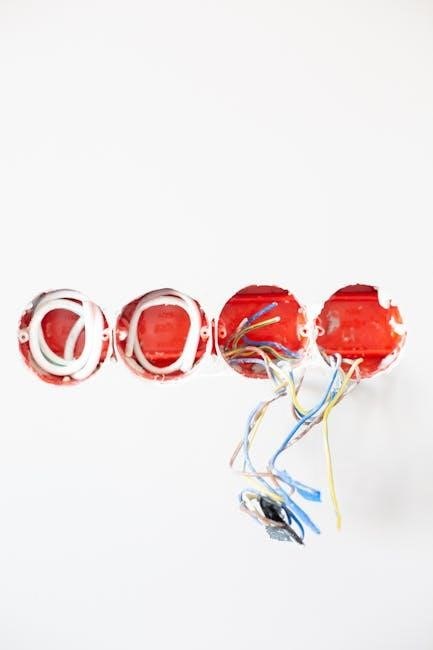Installing a gas wall heater provides efficient, targeted warmth while ensuring safety and energy efficiency․ Proper installation is crucial to avoid hazards and ensure optimal performance․
1․1 Importance of Proper Installation
Proper installation of a gas wall heater is critical for safety, efficiency, and performance․ It ensures compliance with local codes, prevents gas leaks, and avoids potential fire hazards․ Incorrect installation can lead to unsafe operating conditions, reduced efficiency, or even complete system failure․ Always follow manufacturer guidelines and safety protocols to guarantee reliable and hazard-free operation․ Improper installation risks property damage, personal injury, or environmental harm, making it essential to adhere to professional standards and best practices․
1․2 Safety Precautions
Safety precautions are essential to prevent hazards during gas wall heater installation․ Always turn off the gas supply before starting work․ Ensure proper ventilation to avoid gas accumulation․ Use approved materials for gas lines and connections․ Follow manufacturer instructions precisely to prevent leaks or fires․ Keep the area clear of flammable materials․ Test all connections for leaks after installation․ Never proceed without ensuring all safety measures are in place to protect against potential risks․

Pre-Installation Requirements
Before installing a gas wall heater, ensure the location meets safety standards, check local codes, and gather all necessary tools and materials as specified by the manufacturer․
2․1 Choosing the Right Location
Choose a location for your gas wall heater that ensures proper ventilation and safety․ Maintain a minimum distance of 12 cm from the floor and 30 cm from adjacent walls․ Avoid areas near flammable materials or water sources․ Ensure the space is well-ventilated to prevent gas accumulation․ Verify local building codes for specific requirements․ The location must also accommodate the venting system, whether vented or vent-free, as specified by the manufacturer․
2․2 Checking Local Codes and Regulations
Before installing a gas wall heater, verify local building codes and regulations․ Ensure compliance with National Fuel Gas Code (ANSI Z223․1/NFPA 54) or CSA B149․1 standards․ Check requirements for venting, clearance, and gas line installations․ Obtain necessary permits and certifications․ Local authorities may have specific rules for propane or natural gas heaters․ Always adhere to these guidelines to ensure safety and legal compliance, avoiding potential fines or hazards․
2․3 Gathering Necessary Tools and Materials
To begin, gather essential tools like a stud finder, drill, wrenches, and screwdrivers․ Materials needed include approved gas piping, venting components, and mounting hardware․ Ensure you have pipe joint compound, gaskets, and a flexible gas connector if required․ Refer to the manufacturer’s instructions for specific parts․ Having all tools and materials ready ensures a smooth installation process without delays․ Always verify local supplier recommendations for compliance with safety standards․

Preparation for Installation
Start by turning off the gas supply and ensuring the area is clear․ Prepare the wall surface and ensure proper ventilation before proceeding with the installation․
3․1 Turning Off the Gas Supply
Locate the main gas shutoff valve and turn it clockwise to stop gas flow․ Test by attempting to light a stove burner (do not leave it on)․ Ensure the gas supply is completely off before starting installation․ Apply leak detection solution to the valve connection to confirm no gas is escaping․ If unsure, consult a qualified professional to ensure safety and proper shutdown of the gas supply system․
3․2 Preparing the Wall for Mounting
Use a stud finder to locate wall studs and mark the drilling points according to the heater’s manual․ Drill pilot holes and secure the mounting bracket with appropriate hardware․ Ensure the wall surface is flat, undamaged, and clear of obstructions․ Maintain the required clearance from floors (minimum 12 cm) and side walls (minimum 30 cm) for safety․ Verify the bracket is level and tightly fastened before proceeding with the installation․
3․4 Ensuring Proper Ventilation
Proper ventilation is critical for safe operation․ Vented systems require a vent pipe to direct combustion gases outside, while vent-free systems rely on indoor air quality․ For vented models, assemble the vent pipe according to the manufacturer’s instructions, using appropriate gaskets or sealant․ Ensure the vent pipe extends through an outside wall and terminates correctly to prevent gas buildup․ Always consult local codes and the heater’s manual for specific ventilation requirements to ensure compliance and safety․
Installing the Gas Piping
Shut off the gas supply and drill holes for the gas lines․ Connect the piping using approved materials, ensuring all joints are secure and leak-free․ Test thoroughly․
4․1 Shutting Off the Gas Supply
Before starting the installation, locate and turn off the main gas supply valve․ Verify the gas is off by attempting to light a stove burner or using a gas detector․ Ensure no gas is flowing to prevent accidents or leaks during the piping process․ This crucial step ensures safety and allows for secure handling of the gas lines and connections․
4․2 Drilling Holes for Gas Lines
Use a stud finder to locate wall studs and mark the drilling points according to the heater’s manual․ Drill pilot holes for the gas line, ensuring they align with the piping layout․ Verify local codes for hole sizing and placement․ Properly seal the holes with approved materials to maintain airtight connections․ Ensure the gas line fits securely through the drilled holes to support safe and efficient installation․
4․3 Connecting the Gas Line to the Heater
Connect the gas line to the heater using approved piping materials and fittings․ Apply pipe joint compound to all threaded connections and tighten securely with a wrench․ Use a flexible gas connector if required by the manufacturer․ Ensure the line is properly sized and configured to meet local codes․ After connecting, test for leaks using a leak detection solution and follow the manufacturer’s instructions for any necessary adjustments․
4․4 Testing for Gas Leaks
After connecting the gas line, test for leaks to ensure safety․ Apply a leak detection solution or dish soap to all connections․ Slowly turn on the gas supply and inspect for bubbles, which indicate leaks․ If bubbles appear, tighten the connections and retest․ Never use open flames for leak detection․ If leaks persist, turn off the gas supply and consult a professional to avoid hazards․
Mounting the Heater
Secure the mounting bracket to the wall using appropriate fasteners․ Hang the heater on the bracket, ensuring it is level and firmly attached for safe operation․
5․1 Securing the Mounting Bracket
Use a stud finder to locate wall studs and mark drilling points as per the heater’s manual․ Drill pilot holes and secure the bracket with appropriate screws or anchors․ Ensure the bracket is level and tightly fastened to support the heater’s weight․ If studs are unavailable, use wall anchors for added stability․ Maintain the recommended distance from the floor and side walls for safety and proper function․
5․2 Hanging the Heater on the Bracket
Carefully lift the heater and align its mounting holes with the bracket․ Ensure the heater is level and securely fasten it using the screws provided․ Double-check that the heater’s weight is within the bracket’s capacity․ Tighten all fasteners firmly to prevent movement․ Verify that the heater is plumb and level for proper operation․ Once secured, ensure all gas and electrical connections are intact and not strained․ Follow the manufacturer’s instructions for final tightening and alignment․
5․3 Ensuring the Heater is Level
Use a spirit level to ensure the heater is perfectly horizontal and vertical․ Adjust the mounting bracket as needed to achieve proper alignment․ Once level, tighten all screws securely to the wall․ Double-check the alignment to prevent uneven heating or potential safety hazards; Ensure the heater’s position aligns with the venting system and gas line connections for optimal performance and safety; Proper leveling is critical for efficient operation and compliance with safety standards․

Ventilation and Exhaust System
Proper ventilation is critical for safe operation of gas wall heaters․ Ensure correct installation of vent pipes and proper termination to prevent combustion gas hazards and ensure efficiency․
6․1 Understanding Vented vs․ Vent-Free Systems
Vented gas wall heaters require a vent pipe to exhaust combustion gases outside, ensuring safety and efficiency․ Vent-free systems, while convenient, recirculate gases indoors, requiring strict adherence to safety guidelines and local codes to prevent carbon monoxide risks․ Choosing the right system depends on installation location, local regulations, and personal preference, with vented systems often recommended for better safety and airflow management․
6․2 Installing the Vent Pipe
Install the vent pipe according to the manufacturer’s instructions, ensuring it is securely fastened and properly sized․ Use approved materials like stainless steel or double-wall pipes to prevent corrosion and heat damage․ Route the vent pipe through an exterior wall or roof, maintaining the recommended slope to avoid blockages․ Seal all connections with duct sealant and verify proper termination to ensure safe exhaust of combustion gases and compliance with local codes․
6․3 Proper Vent Termination
Ensure the vent pipe terminates outside, at least 12 inches above the roof or 3 feet from any window or door․ Use a vent cap to protect against weather and debris․ Check local codes for specific termination requirements, such as height and clearance from combustible materials․ Proper termination ensures safe exhaust of gases and prevents carbon monoxide buildup, maintaining efficiency and safety for your gas wall heater installation․

Connecting Electrical Components
Connect the heater to a grounded electrical circuit as specified by the manufacturer․ Ensure the voltage matches the heater’s requirements․ Secure all connections tightly and test for proper function to avoid electrical hazards․
7․1 Understanding Electrical Requirements
Understanding the electrical requirements is essential for safe and proper installation․ Ensure the heater is connected to a grounded circuit with the correct voltage rating․ Refer to the manufacturer’s manual for specific voltage and amperage needs․ Always use approved wiring materials and ensure connections are secure to prevent electrical hazards or malfunctions․ Proper electrical setup ensures efficient and safe heater operation․
7․2 Connecting the Heater to Power
Connect the heater to a grounded electrical circuit, ensuring the voltage and amperage match the manufacturer’s specifications․ Use approved wiring materials and follow local electrical codes․ Turn off the power supply before connecting to avoid shocks․ Secure all electrical connections tightly and test for integrity․ Refer to the manual for specific wiring diagrams and guidelines to ensure safe and proper electrical hookup․
7․3 Testing Electrical Connections
After connecting the heater to the power supply, turn off the main power switch and use a multimeter to test for short circuits or improper wiring․ Ensure all connections are secure and meet local electrical codes․ Turn the power back on and check for any sparks or unusual odors․ If issues arise, disconnect the power immediately and consult a licensed electrician to resolve the problem before operating the heater․

Final Testing and Inspection
After installation, test the heater’s operation by following the manufacturer’s instructions․ Ensure all safety features function correctly and check for gas leaks using leak detection solution․ Verify proper ventilation and electrical connections․ Turn on the heater and monitor its performance to ensure it operates smoothly and efficiently․ Address any issues immediately to guarantee safe and reliable use․
8․1 Testing the Heater’s Operation
After installation, turn on the heater to ensure it operates correctly․ Check for proper ignition, consistent flame, and smooth heat distribution․ Refer to the manufacturer’s instructions for specific testing procedures․ Apply leak detection solution to all gas connections to verify no leaks exist․ Ensure the heater’s electrical components, such as thermostats or remote controls, function as intended․ Monitor the unit for unusual noises, odors, or vibrations․ If any issues arise, address them promptly to guarantee safe and efficient operation․
8․2 Checking for Proper Function
Once the heater is operational, monitor its performance to ensure it functions as intended․ Verify consistent heat output, proper airflow, and the responsiveness of controls like thermostats or remotes․ Check that safety features, such as oxygen depletion sensors or emergency shut-offs, activate correctly․ Ensure there are no unusual odors, noises, or fluctuations in heat․ If the heater performs flawlessly, the installation is successful․ If issues arise, refer to the troubleshooting guide or consult a professional․
8․3 Ensuring All Safety Features Work
After installation, test all safety features to ensure they function correctly․ Check oxygen depletion sensors, emergency shut-off valves, and ignition systems․ Verify that the heater shuts off automatically if it detects unsafe conditions, such as low oxygen levels or gas leaks․ Inspect for proper ventilation and ensure no carbon monoxide buildup․ Follow the manufacturer’s instructions for testing procedures․ If any safety feature fails, do not operate the heater until it is repaired by a qualified technician․

Maintenance and Troubleshooting
Regularly inspect and clean the heater, vents, and burners to ensure optimal performance․ Address common issues like ignition problems or gas leaks promptly․ If issues persist, consult a professional․
9․1 Regular Maintenance Tips
Regular maintenance ensures safety and efficiency․ Inspect vents for blockages, clean burners, and check for gas leaks using soap solutions․ Ensure proper clearance around the heater and schedule annual professional inspections․ Keep the heater free from dust and debris to maintain airflow and performance․ Always follow manufacturer guidelines for routine care and address any issues promptly to prevent malfunctions․ Regular upkeep extends the heater’s lifespan and ensures reliable operation․
9․2 Common Issues and Solutions
Common issues with gas wall heaters include gas leaks, ignition problems, and venting malfunctions․ For leaks, apply soap solution to connections; bubbles indicate leaks․ Ignition issues may require cleaning the pilot orifice or replacing the igniter․ Venting problems often result from blockages; inspect and clean vent pipes annually․ If issues persist, consult a professional․ Regular maintenance can prevent many of these problems, ensuring safe and efficient operation․ Always follow manufacturer guidelines for troubleshooting․
9․3 When to Call a Professional
If you encounter complex issues like gas line leaks, venting problems, or electrical malfunctions, it’s best to call a licensed professional․ They can handle intricate repairs, ensure compliance with safety codes, and perform tasks beyond basic maintenance․ Annual inspections by a professional are also recommended to maintain efficiency and safety․ Don’t risk your safety; seek expert help for critical repairs or installations to avoid potential hazards and ensure proper functionality․ Always prioritize professional assistance for major issues․
Proper installation and maintenance of a gas wall heater ensure safety, efficiency, and comfort․ Always follow manufacturer instructions and local codes to avoid hazards and enjoy reliable heating․
10․1 Summary of Key Steps
Successful gas wall heater installation involves selecting the right location, ensuring proper ventilation, securing permits, connecting gas and electrical lines, mounting the heater, and conducting safety checks․ Always follow manufacturer instructions and local codes to ensure compliance and safety․ Regular maintenance and professional inspections are essential for long-term efficiency and reliability․ Proper installation ensures a warm and comfortable living space while minimizing potential risks․
10․2 Final Safety Reminders
Always follow manufacturer guidelines and local codes to ensure safe operation․ Keep flammable materials away from the heater and maintain proper ventilation․ Schedule annual professional inspections to check for leaks or damage․ Never attempt repairs without turning off the gas supply․ Regularly clean and maintain the unit to prevent malfunctions․ By adhering to these safety practices, you ensure a safe and efficient heating experience for years to come․